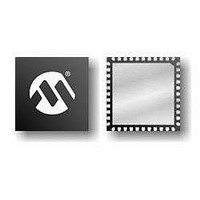PIC16F724-E/MV Microchip Technology, PIC16F724-E/MV Datasheet - Page 90

PIC16F724-E/MV
Manufacturer Part Number
PIC16F724-E/MV
Description
7KB Flash Program, 1.8V-5.5V, 16MHz Internal Oscillator, 8b ADC, CCP, I2C/SPI, A
Manufacturer
Microchip Technology
Series
PIC® XLP™ 16Fr
Datasheet
1.AC164112.pdf
(302 pages)
Specifications of PIC16F724-E/MV
Processor Series
PIC16F
Core
PIC
Program Memory Type
Flash
Program Memory Size
7 KB
Data Ram Size
192 B
Interface Type
I2C, SPI, AUSART
Number Of Timers
3
Operating Supply Voltage
1.8 V to 5.5 V
Maximum Operating Temperature
+ 125 C
Mounting Style
SMD/SMT
Package / Case
UQFN-40
Development Tools By Supplier
MPLAB IDE Software
Minimum Operating Temperature
- 40 C
Core Processor
PIC
Core Size
8-Bit
Speed
20MHz
Connectivity
I²C, SPI, UART/USART
Peripherals
Brown-out Detect/Reset, POR, PWM, WDT
Number Of I /o
36
Eeprom Size
-
Ram Size
192 x 8
Voltage - Supply (vcc/vdd)
1.8 V ~ 5.5 V
Data Converters
A/D 14x8b
Oscillator Type
Internal
Operating Temperature
-40°C ~ 125°C
Lead Free Status / Rohs Status
Details
- Current page: 90 of 302
- Download datasheet (5Mb)
PIC16F72X/PIC16LF72X
7.2
Clock source modes can be classified as external or
internal.
• Internal clock source (INTOSC) is contained
• External clock modes rely on external circuitry for
The system clock can be selected between external or
internal clock sources via the FOSC bits of the
Configuration Word 1.
7.3
The oscillator module has eight output frequencies
derived from a 500 kHz high precision oscillator. The
IRCF bits of the OSCCON register select the
postscaler applied to the clock source dividing the
frequency by 1, 2, 4 or 8. Setting the PLLEN bit of the
Configuration Word 1 locks the internal clock source to
16 MHz before the postscaler is selected by the IRCF
bits. The PLLEN bit must be set or cleared at the time
of programming; therefore, only the upper or low four
clock source frequencies are selectable in software.
7.3.1
The INTOSC and INTOSCIO modes configure the
internal oscillators as the system clock source when
the device is programmed using the oscillator selection
or the FOSC<2:0> bits in the CONFIG1 register. See
Section 8.0
information.
In INTOSC mode, OSC1/CLKIN is available for general
purpose I/O. OSC2/CLKOUT outputs the selected
internal oscillator frequency divided by 4. The CLKOUT
signal may be used to provide a clock for external
circuitry, synchronization, calibration, test or other
application requirements.
In
OSC2/CLKOUT are available for general purpose I/O.
DS41341E-page 90
within the oscillator module and derived from a
500 kHz high precision oscillator. The oscillator
module has eight selectable output frequencies,
with a maximum internal frequency of 16 MHz.
the clock source. Examples are: oscillator mod-
ules (EC mode), quartz crystal resonators or
ceramic resonators (LP, XT and HS modes) and
Resistor-Capacitor (RC) mode circuits.
INTOSCIO
Clock Source Modes
Internal Clock Modes
INTOSC AND INTOSCIO MODES
“Device
mode,
Configuration”
OSC1/CLKIN
for
more
and
7.3.2
The output of the 500 kHz INTOSC and 16 MHz
INTOSC, with Phase Locked Loop enabled, connect to
a postscaler and multiplexer (see Figure 7-1). The
Internal Oscillator Frequency Select bits (IRCF) of the
OSCCON register select the frequency output of the
internal oscillator. Depending upon the PLLEN bit, one
of four frequencies of two frequency sets can be
selected via software:
If PLLEN = 1, frequency selection is as follows:
• 16 MHz
• 8 MHz (Default after Reset)
• 4 MHz
• 2 MHz
If PLLEN = 0, frequency selection is as follows:
• 500 kHz
• 250 kHz (Default after Reset)
• 125 kHz
• 62.5 kHz
There is no start-up delay before a new frequency
selected in the IRCF bits takes effect. This is because
the old and new frequencies are derived from INTOSC
via the postscaler and multiplexer.
Start-up delay specifications are located in the
Table 23-2
Specifications”.
Note:
FREQUENCY SELECT BITS (IRCF)
Following any Reset, the IRCF<1:0> bits of
the OSCCON register are set to ‘10’ and
the frequency selection is set to 8 MHz or
250 kHz. The user can modify the IRCF
bits to select a different frequency.
in
© 2009 Microchip Technology Inc.
Section 23.0
“Electrical
Related parts for PIC16F724-E/MV
Image
Part Number
Description
Manufacturer
Datasheet
Request
R

Part Number:
Description:
IC PIC MCU FLASH 4KX14 44-QFN
Manufacturer:
Microchip Technology
Datasheet:

Part Number:
Description:
IC PIC MCU FLASH 4KX14 44TQFP
Manufacturer:
Microchip Technology
Datasheet:

Part Number:
Description:
IC PIC MCU FLASH 4KX14 40-DIP
Manufacturer:
Microchip Technology
Datasheet:

Part Number:
Description:
7KB Flash Program, 1.8V-5.5V, 16MHz Internal Oscillator, 8b ADC, CCP, I2C/SPI, A
Manufacturer:
Microchip Technology
Datasheet:

Part Number:
Description:
7KB Flash Program, 1.8V-5.5V, 16MHz Internal Oscillator, 8b ADC, CCP, I2C/SPI, A
Manufacturer:
Microchip Technology
Datasheet:

Part Number:
Description:
7KB Flash Program, 1.8V-5.5V, 16MHz Internal Oscillator, 8b ADC, CCP, I2C/SPI, A
Manufacturer:
Microchip Technology
Datasheet:

Part Number:
Description:
7KB Flash Program, 1.8V-5.5V, 16MHz Internal Oscillator, 8b ADC, CCP, I2C/SPI, A
Manufacturer:
Microchip Technology

Part Number:
Description:
IC PIC MCU FLASH 2KX14 28-QFN
Manufacturer:
Microchip Technology
Datasheet:

Part Number:
Description:
IC PIC MCU FLASH 2KX14 28-SOIC
Manufacturer:
Microchip Technology
Datasheet:

Part Number:
Description:
IC PIC MCU FLASH 2KX14 28DIP
Manufacturer:
Microchip Technology
Datasheet:

Part Number:
Description:
IC PIC MCU FLASH 2KX14 28-SOIC
Manufacturer:
Microchip Technology
Datasheet:

Part Number:
Description:
IC PIC MCU FLASH 2KX14 28QFN
Manufacturer:
Microchip Technology

Part Number:
Description:
IC PIC MCU FLASH 2KX14 28SSOP
Manufacturer:
Microchip Technology

Part Number:
Description:
IC PIC MCU FLASH 2KX14 8-SSOP
Manufacturer:
Microchip Technology
Datasheet:

Part Number:
Description:
IC PIC MCU FLASH 2KX14 28-SSOP
Manufacturer:
Microchip Technology
Datasheet:










